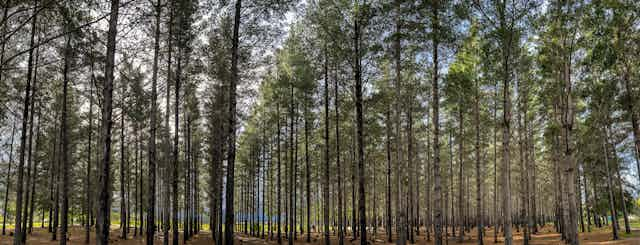In the 1970s and 1980s, pine trees growing in various forestry plantations in South Africa’s Western Cape province began to die in patches. These trees succumbed to a mysterious root disease and the patches expanded gradually. Spontaneous regrowth of seedlings in the patches died dramatically.
As in many other true crime dramas, the finger was initially pointed at the most likely suspect: the root-infecting Phytophthora cinnamomi. Its name – plant (phyto) destroyer (phthora) – reveals its power to cause harm; the pathogen is known to cause disease in almost 5,000 different plants.
After further investigation and the collection of many samples, tree pathologists shifted the blame onto the fungus Leptographium serpens (now known as Leptographium alacre). This fungus is well known to be transported by insects and was previously only known in Europe. It was visually identified from the roots of the dying trees. Now it was the prime suspect.
Doubts lingered, though. Most Leptographium species are not known to act as primary disease agents and so L. serpens was most likely not able to cause the disease. Other fungi were also found within the roots of the diseased trees but could not be identified at the time due to a lack of more advanced techniques.
Knowing that the then-available technologies could not provide the complete answer to this mystery, the pathologists took more samples from the dead and dying pine trees, and stored them carefully. The hope was that one day they would have a better idea of the cause of this disease outbreak.
Fast forward to 2023 and a new character enters the mystery: DNA sequencing. This modern technology did what wasn’t possible a few decades ago, allowing our team of molecular mycologists to identify the real culprit.
This tale is a testament to the ever-evolving nature of scientific inquiry. It reinforces the idea that, in the pursuit of knowledge, no stone should be left unturned and no assumption should be taken for granted. Through a blend of perseverance, technology, and a touch of serendipity, it was possible to solve a decades-old mystery.
Tracking a killer
Back in the 1980s the samples were stored in the culture collection of the Forestry and Agricultural Biotechnology Institute at the University of Pretoria. In 2020, the samples were revived by a team that included ourselves and several others who recently published a paper on the topic.
We sequenced the samples’ DNA to reveal their unique genetic code. By comparing this code against genetic databases, it was possible to figure out exactly what was causing the tree disease. And so, more than four decades after the disease was first described, the pathogen was finally identified as Rhizina undulata. L. serpens, the long time primary suspect, was finally exonerated.

Rhizina undulata is well known to cause tree disease and death, mainly in Europe. This fungus is known colloquially as the “coffee fire fungus” because the intense heat caused by fires made by campers in a forest to brew coffee activates its dormant spores. This allows it to colonise the roots of conifers, including pines. R. undulata is also well known in South Africa, where it kills many pines in the aftermath of forest fire and when trees are felled to clear a plantation.
What remains a mystery, however, is the trigger that activated this fungus in the Western Cape plantations. No fires were known to have occurred during the relevant time period.
One potential clue to the trigger may lie in the soil in which these trees were planted. Known as Table Mountain sandstone, this soil is sandy and acidic. Acidic soil has been shown in the laboratory to encourage R. undulata growth. This naturally occurring acidity may have been the nudge the pathogen needed to infect the pine trees. It is also possible that the fungus was activated by heat radiating from the quartz rocks that are common in the areas in which the dying trees were planted.
It pays to be patient
In the years since the mysterious Western Cape outbreak, R. undulata has become well known to foresters in pine plantations in other parts of South Africa and has done great damage to newly planted trees after fires. These fires can be accidental or due to what is known as slash-burning after trees are harvested.
Identifying R. undulata as the culprit in those (no longer active) Western Cape plantations means scientists have more data that might help to better understand the biology of the fungus – which may lead to better control strategies in the future.
Our work is also a testament to the timeliness of scientific progress and the importance of patience. This story could only be fully unravelled when more advanced techniques were developed. It shows the power of modern technologies to solve historical problems. This underlines the need for continued investment into research and the development of new tools, both in South Africa and worldwide.
Our study also strongly advocates for the preservation of diverse fungal cultures for extended periods of time, regardless of their perceived importance at the time they are collected. The lack of accessible culture collections for lesser-known fungi, in South Africa and internationally, highlights the need for innovative approaches to safeguard these invaluable resources. This shift could revolutionise the study of microbes, opening new avenues beyond traditional species descriptions.

